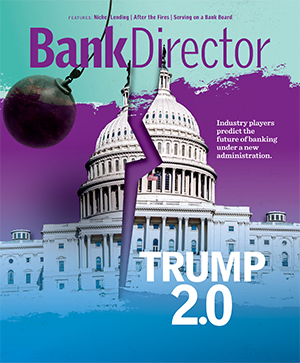Mike Downey is the Director of Insurance Solutions & Executive Benefits at Alden Investment Group, bringing 34 years of industry experience to the firm. He provides innovative insurance and executive benefits strategies for institutional and retail clients. For the past 20 years, Mike has specialized in working with depository and financial institutions, helping them implement strategies to retain, recruit, and retire senior executives. His expertise in advanced insurance solutions makes him a valuable resource for financial advisors and retail clients, particularly in wealth transfer and business continuity. Mike is committed to providing tailored insurance and financial solutions that support the long-term success of Alden’s clients and partners.

Incorporating a Unique Benefit into Your Bank’s Succession Planning
As banks navigate leadership transitions, an economic benefit split dollar life insurance plan provides a strategic solution, benefitting both executives and the institution.
Brought to you by Alden Investment Group

While effective succession planning is crucial for banks of all sizes, incorporating an economic benefit split dollar life insurance plan (EBSD) with a succession plan can lower the bank’s organizational risk by offering stability for your leadership team. EBSD is a creative life insurance plan that allows the bank to provide a tax-advantaged benefit to key executives, helping to retain and reward top talent.
A traditional supplemental executive retirement plan (SERP) is often designed to benefit employees over the long term, focusing on retirement age. However, this long-term incentive does not effectively retain younger executives, especially when competing organizations offer them their dream positions. A well-structured EBSD provides short-, intermediate- and long-term incentives within a single framework. An EBSD plan is essential when the bank identifies internal successors and invests in their development and advancement. It’s crucial to ensure that your investment in human capital stays with you, preventing it from moving elsewhere. Retaining talent is vital; your bank should not become a talent pool for competitors but should cultivate excellence among its staff.
Here are the key advantages of an EBSD plan:
1. Retains key employees during leadership transitions. A well-structured EBSD plan ensures continuity in leadership by minimizing disruptions, retaining institutional knowledge and preserving the bank’s unique culture. This strategy reduces uncertainty and instability during executive transitions while helping to maintain positive employee morale and client confidence.
2. Provides customized and flexible benefits for executives. Unlike rigid compensation structures, EBSD plans can be tailored to meet individual executives’ financial goals and career timelines. These plans align with the organization’s succession strategies and the executives’ financial commitments. Furthermore, an EBSD plan can assist with significant life events, such as children’s college expenses, weddings and home purchases, motivating executives to stay engaged by providing immediate and future value.
3. Reinforces leadership commitment and career growth. Executives who feel appreciated and fairly compensated are more likely to remain with the organization. An EBSD plan illustrates a leadership team’s dedication to employees’ long-term success and commitment to their professional development. Additionally, it enhances the bank’s reputation as a workplace.
4. Presents built-in flexibility to protect the bank. Traditional SERPs and many executive compensation plans often face strict regulations. EBSD provides inherent flexibility, allowing for necessary changes. These plans adapt to market conditions, regulatory updates or changes in the business environment, and they are less restrictive than traditional benefit plans, facilitating more strategic adjustments over time.
5. Offers an ideal solution for family-owned and S corporation banks. Family-owned banks and S corps require effective methods to compensate key non-shareholder executives without diluting equity or incurring excessive corporate liabilities. EBSD enables banks to reward top performers without issuing stock. Its versatile design allows family-owned banks to provide liquidity for paying any inheritance or estate tax, eliminating the need for heirs to sell bank stock to cover taxes.
6. Adds an important asset in mergers and acquisitions. Whether a bank is the acquirer or the target, an EBSD plan can be a strategic asset in M&A. It can help retain top talent following the acquisition, structure severance packages with minimal costs and provide customizable change-in-control features to ensure leadership stability and protect executives.
7. Supports charitable giving and community impact. EBSD can be structured to provide a substantial endowment or gift to local charities. The flexibility and agility of the death benefit can provide cost recovery for the bank, a self-completing plan for the employee’s family and a cash endowment for charities of your choice.
8. Addresses rising long-term care and healthcare costs. Many executives face the financial burden of caring for aging family members or managing unexpected medical expenses. Some EBSD policies provide access to funds to assist with long-term care expenses. These plans can cover costs related to Alzheimer’s, cancer treatments or terminal illnesses, giving executives peace of mind, knowing their families are financially secure.
9. Provides tax-advantaged compensation and retirement income. Typically, SERPs provide executives with taxable retirement income, whereas EBSD offers non-taxable retirement income, thus enhancing net financial gains and presenting a more cost-effective solution.
Future-Proofing Your Bank With EBSD
As banks navigate leadership transitions, face talent retention challenges, and adapt their compensation strategies, EBSD provides a highly customizable and strategic solution that benefits both executives and the institution.
If your bank invests in leadership development and aims to ensure long-term executive stability, now is the time to explore how an EBSD plan can improve your succession planning strategy.


